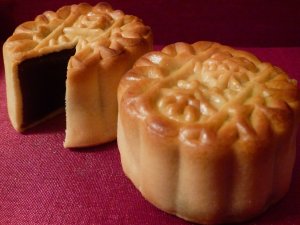Today marks the time of year when millions of Chinese families around the world celebrate the Mid-Autumn or Moon Festival. It’s been described as the Chinese equivalent of Thanksgiving, and has been celebrated since the Tang Dynasty in 618 AD. Traditionally, family and friends gather to eat pastries called mooncakes under the light of the full moon, whose roundness represents completeness and abundance. The best known version of mooncakes are the Cantonese version, dense pastries with a golden chewy crust, traditionally filled with pastes made of lotus seeds, dates, beans, and sometimes seeds and a salted egg yolk. Another version is called a snow skin moon cake– these are clad in lighter, flaky pastry made of mochi (glutinous rice) flour. Pomelos, the Asian citrus resembling a moon-sized grapefruit, are also traditionally enjoyed during this festival. As with harvest festivals in other cultures, this was traditionally a time for farmers to celebrate the end of the summer harvest season.
This is one of the Chinese traditions I didn’t grow up celebrating. One of my first memories of celebrating the festival was when I spent part of my junior year in college abroad in Singapore. My new friends, incredulous that I didn’t know much about the Mid-Autumn Festival, bought some delicious green tea moon cakes and served them with exquisite oolong tea, which they poured traditionally in a Chinese terra cotta tea service. Despite the starkness of the dormitory’s architecture, it was a special and welcoming moment.
And for some literary sustenance, here’s a classical Chinese poem that was written on the occasion of the Mid-Autumn Festival. For those who cannot reunite with their families for the festival, the poem reassures that no matter how far two people are separated by distance, they can take comfort in knowing that they gaze at the same moon.
Thinking of You
When will the moon be clear and bright?
With a cup of wine in my hand, I ask the blue sky
I don’t know what season it would be
In the heavens on this night
I’d like to ride the wind to fly home
Yet I fear the crystal and jade mansions are
Much too high and cold for me
Dancing with my moon-lit shadow
It does not seem like the human world
The moon rounds the red mansion
Stoops to silk-pad doors
Shines upon the sleepless
Bearing no grudge
Why does the moon tend to be full when people are apart?
People may have sorrow or joy, be near or far apart
The moon may be dim or bright, wax or wane
This has been going on since the beginning of time
May we all be blessed with longevity
Though far apart, we are still able to
share the beauty
of the moon together.
On the Mid Autumn Moon Festival of the year 1076,
I drank happily till dawn
and wrote this in my cups
while thinking of my brother Ziyou.
– Su Shi (Su Dong Po) 1076 A.D.
(Translation by Li Shun-Yi in 1998. Source: Chuck@China)


